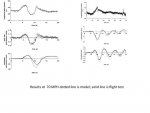If OTOH the gyro relies on rotor thrust to keep the airframe upright (as does a gyro with uncompensated engine torque and/or high thrustline), then trouble begins the iNSTANT rotor thrust diminishes. The aircraft will begin to roll and/or begin a PPO. The pilot has limited ability to control the craft with the stick, because tilting the rotor does nothing at zero G.
o.
Doug,
Consider the Magni or MTO. Depending on the model and loading you get 8 to 13 inch thrust- CG offset for both brands per CAA section-t airworthiness testing. In both cases the prop thrust is balanced by RTV, in other words the RTV is ahead of the CG. The tail is carrying under 10 pounds of load. In other words, per your above quote, you would say these two models are both PPOs waiting to happen.
Yet, they have passed more stringent professionally conducted airworthiness flight tests than any other model.They are more numbers of these two manufacturers flying today than all the others put together. So far not a single case of PPO. Why?
There are two problems with your above analysis:
1. how does the low g happen? If it is not the pilot deliberately flying a parabola then it must be an atmospheric gust. Now, as long as the gyro is AOA stable such a gust will cause the gyro to pitch in a direction that neutralizes the effect of the gust. In the Magni and MTO3 it is the stab that gives the AOA stability despite the RTV being ahead of the CG. PPO is not some special case it is a garden variety of AOA instability. It is a runaway condition a small decrease in AOA resulting in a nose down motion that further reduces the AOA and so on.
2. There is another force in play in a zero G event - gravity- that is ignored in all descriptions of PPO I have seen.
When a gyro is in a zero (or Low) G condition it is falling or accelerating towards the earth. This increases the AOA of the rotor in effect loading the blades. This effect is not small. At 30 MPH airspeed the AOA would increase by about 30 degrees per sec in a zero G event.
Now further if the gyro is AOA stable (due to a stab)it would pitch up into the gust, further increasing the AOA and loading the rotor. Both these effects (falling and AOA stability) work in the same direction and as you can see there is no run away condition and no PPO.
Now if the gyro is AOA unstable the vertical acceleration (falling) would help with loading the rotor while the AOA instability will attempt to unload the rotor further. At low speeds the falling dominates. At some critical speed the AOA instability wins and you get a run away PPO condition.But this is only possible in gyros that are unstable wrt AOA.
Bottom line, AOA stability is the vaccine to inoculate against gust induced PPO. It does not matter where the RTV is wrt CG.

